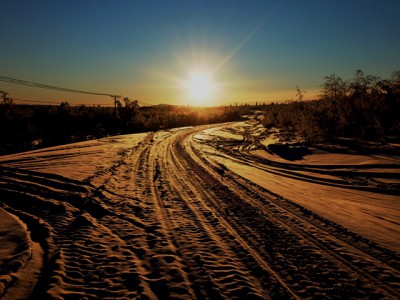I like that history doesn’t get covered up here. When things reach their natural – or unnatural – end, they stay there.
One of Kiruna’s four roads out of town (the road to Nikkaluokta, and one of the two roads out of town that’s a dead end) has been closed off. I suppose you’d say it’s reached a rather unnatural end. There was nothing wrong with it, but it’s too near the mining area and the land will become unstable. A new road has been built a kilometre away, linking up with the old road behind the mine where there’s no threat of subsidence.
The old road is closed off to traffic. Freed from the tyranny of the car, it’s opened up to everyone else. I watched a fox shoot along it, a flash of red brown flying through white, fast as a car but quieter, more mysterious.
Less quiet and mysterious, snow scooters can sometimes travel this way. These noisy, smelly machines do serve the useful purpose of flattening newly fallen snow making it possible to walk on, so the road has also opened up to walkers and runners. Or at least to one walker and runner – I haven’t met anyone else on it yet.
I know the road so well from a car but this is the first time I’ve experienced it at first hand, beyond the car window. I have to resist the temptation to look behind me all the time, to see if I’m in the way of a passing car. There are just the ghosts of old cars now. It’s snow-covered, very quiet, very empty.
It’s clearly still a road though. If it were somewhere else it would soon become something else – a supermarket, a block of flats, or another road even – but here the world has just packed up and moved on and left it – it’s the old road to Nikkaluokta and it will be that for the foreseeable future. It’s returning to the landscape it came from, only very very slowly.
The view of Kiruna town from the road is brilliant – you can see it from one end to the other, the church and town hall clock tower standing in the skyline next to the slope of Luossavaara, the companion hill facing the mine. In a car it was hard to enjoy it, since there was only one place to stop and admire it. Now, as a walker, you can see it at different heights and different angles and let your eye follow identifiable parts of the town.
As I’m running I listen for the muffled stirrings of animals and birds in the bushes. Mostly these are imagined, but that’s good enough for me. Mainly I hear the snow crunching beneath me at every step, the sound becoming more hollow as the road turns to a colder direction, more softly crunching as it turns back in the direction of the sun. The journey is much longer and more challenging without a car. Every turn in the road is a milestone of sorts, and as twilight begins to bring darkness I’m aware I didn’t bring a phone, there’s no-one here, and there won’t be anyone passing by. Still I push on to the next bend, just to see how it feels. It feels joyous.


